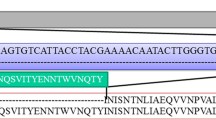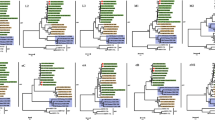Abstract
Tembusu virus (TMUV) has caused significant economic losses in the Chinese duck industry and may have been overlooked regarding its zoonotic transmission potential. A novel TMUV isolate (named CQW1) was separated from the liver tissue of a young duck in Southwest China. The CQW1 isolate proliferated in embryonated duck eggs and led to death within 3-4 days post-inoculation. Furthermore, CQW1 replicated in duck embryo fibroblast (DEF) cells and caused a cytopathic effect (CPE). The disease emerged on a duck farm in Southwest China and was reproduced by animal experiment. We found that CQW1 was detectable by RT-PCR in brain and liver tissues of dead ducklings within 5 days after inoculation. Most importantly, concentrated nuclei, neuronophagia and microglial nodules were observed in the brain tissue of the inoculated ducklings, and additionally, the liver tissue was affected, mainly by disordered lobular architecture, degeneration, necrosis and regenerated hepatocytes. Analysis of the complete genome sequence showed that CQW1 was 10,992 nt in length with two nucleotide insertions and shared 96.8 % to 99.1 % and 98.4 % to 99.6 % identity at nucleotide and amino acid level, respectively, with Chinese isolates. Phylogenetic analysis of the nucleotide sequences demonstrated that the CQW1 isolate was closely related to other members of the genus Flavivirus and formed a new clade together with the GX2013H isolate. Also, the CQW1 isolate demonstrated the highest average pairwise distance value among the Chinese isolates. In the present study, we obtained evidence that TMUV is present in Southwest China. Extensive pathological and epidemiological studies are urgently needed.




Similar content being viewed by others
References
Bai X, Lv R, Liu C, Qiu N, He Y, Yin X, Li X, Liu M, Zhang Y (2013) Molecular characterization of a duck Tembusu virus from China. Virus Genes 47:478–482
Cao Z, Zhang C, Liu Y, Ye W, Han J, Ma G, Zhang D, Xu F, Gao X, Tang Y (2011) Tembusu virus in ducks, china. Emerg Infect Dis 17:1873–1875
Liu M, Chen S, Chen Y, Liu C, Chen S, Yin X, Li G, Zhang Y (2012) Adapted Tembusu-like virus in chickens and geese in China. J Clin Microbiol 50:2807–2809
Chen S, Wang S, Li Z, Lin F, Cheng X, Zhu X, Wang J, Chen S, Huang M, Zheng M (2014) Isolation and characterization of a Chinese strain of Tembusu virus from Hy-Line Brown layers with acute egg-drop syndrome in Fujian, China. Arch Virol 159:1099–1107
Emanuelsson O, Brunak S, von Heijne G, Nielsen H (2007) Locating proteins in the cell using TargetP, SignalP and related tools. Nat Protoc 2:953–971
Friebe P, Harris E (2010) Interplay of RNA elements in the dengue virus 5’ and 3’ ends required for viral RNA replication. J Virol 84:6103–6118
Gould E, Solomon T (2008) Pathogenic flaviviruses. Lancet 371:500–509
Grau-Roma L, Crisci E, Sibila M, Lopez-Soria S, Nofrarias M, Cortey M, Fraile L, Olvera A, Segalés J (2008) A proposal on porcine circovirus type 2 (PCV2) genotype definition and their relation with postweaning multisystemic wasting syndrome (PMWS) occurrence. Vet Microbiol 128:23–35
Gritsun T, Gould E (2006) Origin and evolution of 3’UTR of flaviviruses: long direct repeats as a basis for the formation of secondary structures and their significance for virus transmission. Adv Virus Res 69:203–248
Gubler DJ, Kuno G, Markoff L (2007) Flaviviruses. Fields Virol 1:1153–1253
Huang X, Han K, Zhao D, Liu Y, Zhang J, Niu H, Zhang K, Zhu J, Wu D, Gao L (2013) Identification and molecular characterization of a novel flavivirus isolated from geese in China. Res Vet Sci 94:774–780
J-i Imoto, Konishi E (2007) Dengue tetravalent DNA vaccine increases its immunogenicity in mice when mixed with a dengue type 2 subunit vaccine or an inactivated Japanese encephalitis vaccine. Vaccine 25:1076–1084
Kumar S, Nei M, Dudley J, Tamura K (2008) MEGA: a biologist-centric software for evolutionary analysis of DNA and protein sequences. Brief Bioinform 9:299–306
Lindenbach BD, Rice CM (2003) Molecular biology of flaviviruses. Adv Virus Res 59:23–62
Liu P, Lu H, Li S, Wu Y, Gao GF, Su J (2013) Duck egg drop syndrome virus: an emerging Tembusu-related flavivirus in China. Sci China Life Sci 56:701–710
Mukhopadhyay S, Kuhn RJ, Rossmann MG (2005) A structural perspective of the flavivirus life cycle. Nat Rev Microbiol 3:13–22
Paes MV, Lenzi HL, Nogueira ACM, Nuovo GJ, Pinhão ÂT, Mota EM, Basílio-de-Oliveira CA, Schatzmayr H, Barth OM, de Barcelos Alves AM (2009) Hepatic damage associated with dengue-2 virus replication in liver cells of BALB/c mice. Lab Investig 89:1140–1151
Pandey BD, Karabatsos N, Cropp B, Tagaki M, Tsuda Y, Ichinose A, Igarashi A (1999) Identification of a flavivirus isolated from mosquitos in Chiang Mai Thailand. SE Asian J Trop Med 30:161–165
Su J, Li S, Hu X, Yu X, Wang Y, Liu P, Lu X, Zhang G, Hu X, Liu D (2011) Duck egg-drop syndrome caused by BYD virus, a new Tembusu-related flavivirus. PLoS ONE 6:e18106
Tang Y, Diao Y, Chen H, Ou Q, Liu X, Gao X, Yu C, Wang L (2013) Isolation and genetic characterization of a tembusu virus strain isolated from mosquitoes in Shandong, China. Transbound Emerg Dis 62:209–216
Tang Y, Diao Y, Yu C, Gao X, Ju X, Xue C, Liu X, Ge P, Qu J, Zhang D (2013) Characterization of a Tembusu virus isolated from naturally infected house sparrows (Passer domesticus) in Northern China. Transbound Emerg Dis 60:152–158
Tang Y, Gao X, Diao Y, Feng Q, Chen H, Liu X, Ge P, Yu C (2013) Tembusu virus in human, China. Transbound Emerg Dis 60:193–196
Wan C, Huang Y, Fu G, Shi S, Cheng L, Chen H (2012) Complete genome sequence of avian Tembusu-related virus strain WR isolated from white Kaiya ducks in Fujian, China. J Virol 86:10912
Wang J, Liu W, Meng G, Zhao K, Gu J, Chen P, Cao R (2015) Isolation and genome characterization of a novel duck Tembusu virus with 74 nucleotides insertion in the 3′ non-translated region. Avian Pathol 44:92–102
Wang Y, Yuan X, Li Y, Yu K, Yang J, Xu H, Zhang Y, Liao M, Qin Z (2011) Rapid detection of newly isolated Tembusu-related Flavivirus by reverse-transcription loop-mediated isothermal amplification assay. Virol J 8:553–560
Wu L, Liu J, Chen P, Jiang Y, Ding L, Lin Y, Li Q, He X, Chen Q, Chen H (2014) The sequential tissue distribution of duck Tembusu virus in adult ducks. Biomed Res Int. doi:10.1155/2014/703930
Xie Z, Zeng T, Xie L, Deng X, Xie Z, Liu J, Fan Q, Pang Y, Luo S (2014) Genome analysis of a Tembusu virus, GX2013H, isolated from a Cheery Valley duck in Guangxi, China. Genome Announc 2:e00466-00414
Yan P, Zhao Y, Zhang X, Xu D, Dai X, Teng Q, Yan L, Zhou J, Ji X, Zhang S (2011) An infectious disease of ducks caused by a newly emerged Tembusu virus strain in mainland China. Virology 417:1–8
Yun T, Ye W, Ni Z, Zhang D, Zhang C (2012) Identification and molecular characterization of a novel flavivirus isolated from Pekin ducklings in China. Vet Microbiol 157:311–319
Zhu W, Chen J, Wei C, Wang H, Huang Z, Zhang M, Tang F, Xie J, Liang H, Zhang G (2012) Complete genome sequence of duck Tembusu virus, isolated from Muscovy ducks in southern China. J Virol 86:13119
Author information
Authors and Affiliations
Corresponding authors
Additional information
K. Zhu, J. Huang, R. Jia and B. Zhang contributed equally to this article.
Rights and permissions
About this article
Cite this article
Zhu, K., Huang, J., Jia, R. et al. Identification and molecular characterization of a novel duck Tembusu virus isolate from Southwest China. Arch Virol 160, 2781–2790 (2015). https://doi.org/10.1007/s00705-015-2513-0
Received:
Accepted:
Published:
Issue Date:
DOI: https://doi.org/10.1007/s00705-015-2513-0




